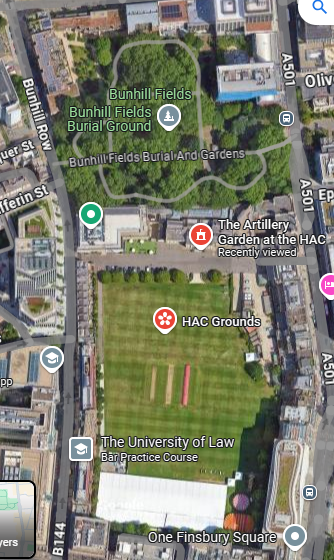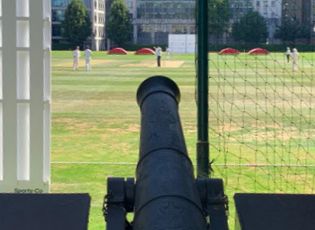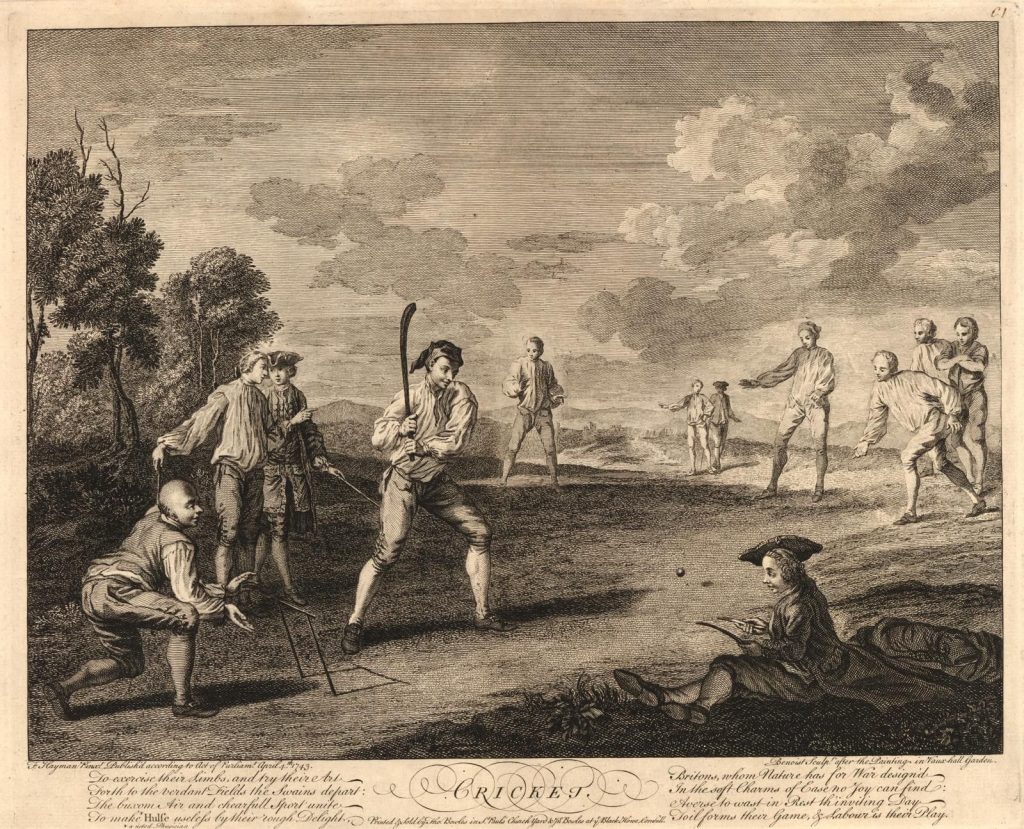The Artillery Ground
The Artillery Ground in London, located in Finsbury in Central London, on the edge of the City, staged more Important Matches in the Eighteenth Century than any other ground. This fact alone makes it hugely significant in the history of cricket. Remarkably, it remains in current use, still owned by the Honourable Artillery Company. Its story says a great deal about the development of cricket from a rural pastime to a professional sport.
History
Pre-cricket
The Artillery Ground was originally the outer precinct of the Priory and Hospital of St Mary Spital. In 1538, King Henry VIII converted it into an artillery ground for the Fraternity or Guild of Artillery of Longbows, Crossbows and Handguns. This group later became known as the Honourable Artillery Company (HAC), who retain the ground to this day. The HAC had a reputation as the fashionable militia for sons of wealthy London citizens.
Heyday as a cricket ground
In the early part of the Eighteenth Century, cricket was gaining ground rapidly, not merely as a rural or school pursuit but as a game played in London by adults for high stakes and on which large sums were wagered. Places like Blackheath, Kennington Common and White Conduit Fields had staged Important Matches. At this time, it was the Artillery Ground that emerged as the venue most able to fill the need for a leading venue for financially important cricket matches. It was the home of the London Cricket Club, and nearly all matches took place under their name, so the story of the ground is closely entwined with the history of that club.
Our first record of cricket being played on the ground was 1724, and the first Important match, 1730. The first lessor and manager of the ground we know of was Christopher Jones, landlord of the nearby Pied Horse Inn. Jones’ successor, both as ground lessor and pub landlord, was George Smith, noted for his entrepreneurship and successful promotion of the ground. The ground was fenced off, so he was able to charge for admission, generally 2d, even for big matches, the entrance being through the yard of the Pied Horse Inn. The ground, it seems, was often full for matches (attendances of up to 8,000 were reported), generally with working-class spectators rather than wealthy patrons, who nevertheless did attend and were accommodated in special seating areas.
One match, between England and Kent in 1744, experienced crowd trouble, so steps were taken to prevent to recurrence. A ring of benches was set around the ground, stewards were employed who wielded whips, and the admission price rose to 6d. The rise in admission prices did not work, and crowds fell abruptly. In 1748, Smith was declared bankrupt, though he somehow retained control of the ground until 1752.
A ticket for a match at the Artillery Ground, England v Kent (1744). The engraving is from Boitard, Smith is the name of the Artillery ground promoter. The price, two shillings, six pence, is quite expensive, perhaps £40 in today’s money. What a wonderful survival!
By then, cricket in the capital was losing something of its lustre. The Artillery Ground itself was developing a reputation for disorderly conduct and for the prevalence of gambling. Perhaps it was just slipping out of fashion. In any case, this sense of decline was accelerated by the Seven Years’ War (1756–1763), which, it seems, made London a less attractive place for the aristocracy and caused a retreat to rural estates. Only five Important matches were held in the 1760s, and though there were more matches in the 1770s, they did not have the same impact as those of earlier years. In any case, they were not welcomed by the owners, and in 1773, the HAC attempted to block all cricket from the ground. Although some major matches continued through to 1778, that was to be the end of the ground’s life as a major cricket venue.
Modern times
The first ever balloon flight in the United Kingdom was that of Mr. Vincent Lunardi, who took off from the Artillery Ground in 1784.
In 1834, the HAC was petitioned with a request to resume hosting matches, with one argument being that it would attract potential recruits to the company. Cricket eventually restarted in 1846, but was limited to members of the HAC and the HAC CC was formally founded in 1860. The HAC runs a strong fixture list to this day.

Google Earth view of the Ground as it is now. The other feature that survives from the great days of the ground is the non-Conformist Bunhill Fields Burial Ground to the North; it was then the case that there were fewer obstacles between the burial ground and the cricket field. There are many records of people climbing the walls of the burial ground to get a sight of the action or, perhaps, to get in without payment.
The Artillery Ground is now surrounded on all sides by substantial buildings, it is a little-known island of greenery in the midst of incredibly valuable real estate.

The match in progress here is HAC v MCC, 2022, a fixture loaded with historic resonance. The gun is for effect only.
A game at the Artillery Ground, 2021:
Famous illustration

An engraving by C. Benoist, after an Oil painting by Francis Hayman, RA, based on the earliest depiction of a cricket match that we know of; obviously, this is a very important artwork and one that is much copied. The original by Hayman is now lost but used to hang in a supper-box at Vauxhall Gardens (opened 1735).
The painting has come to be known as Cricket at the Artillery Ground, but this is a misnomer. The picture was originally described as A Game of Cricket as played in the Artillery Ground, and the misunderstanding arose from that. In fact, the Artillery Ground was walled in, so this picture is obviously of somewhere else.
Important Matches
| Date | Home team | Away team | |
| 1 | 31 Aug 1730 | London | Surrey |
| 2 | 04 Sep 1730 | London | Surrey |
| 3 | 05 Jun 1731 | London | Dartford |
| 4 | 24 Jun 1731 | London | Dartford |
| 5 | 05 Jul 1731 | London | Dartford |
| 6 | 26 Jul 1731 | London | Croydon |
| 7 | 15 Sep 1731 | London | Croydon |
| 8 | 07 Jun 1732 | London | Surrey |
| 9 | 29 Aug 1732 | London | Surrey |
| 10 | 11 Sep 1732 | London | Surrey |
| 11 | 13 Sep 1732 | London | Middlesex |
| 12 | 28 May 1733 | London | Greenwich |
| 13 | 05 Jul 1733 | London | Kent |
| 14 | 12 Sep 1733 | London | Kent |
| 15 | 26 Sep 1733 | London | Croydon |
| 16 | 19 Jun 1734 | London | Kent |
| 17 | 01 Aug 1734 | London | Croydon |
| 18 | 18 Jun 1735 | London | Surrey |
| 19 | Jul 1736 | London | Chertsey |
| 20 | 14 Jul 1736 | London | Surrey |
| 21 | 25 Jul 1737 | London | Essex |
| 22 | Jul 1738 | London | Chislehurst |
| 23 | 11 Aug 1738 | London | Mitcham |
| 24 | Sep 1738 | London | Chislehurst |
| 25 | 27 Jun 1739 | London | Lingfield |
| 26 | 23 Jul 1739 | England | Kent |
| 27 | 05 Sep 1739 | London | Chislehurst |
| 28 | Jun 1740 | London | Chislehurst |
| 29 | 16 Jul 1740 | London | Richmond and Moulsey |
| 30 | 28 Jul 1740 | London | Kent |
| 31 | 15 Sep 1740 | London | Berkshire, Buckinghamshire and Hertfordshire |
| 32 | 15 Jun 1741 | London | Surrey |
| 33 | 03 Jul 1741 | London | Chislehurst |
| 34 | 31 Jul 1741 | London | Surrey |
| 35 | 14 Sep 1741 | London | Surrey |
| 36 | 14 Jun 1742 | London | Bromley |
| 37 | 07 Jul 1742 | London | Richmond |
| 38 | 26 Jul 1742 | London | Croydon |
| 39 | 09 Aug 1742 | London | Bromley |
| 40 | 16 Aug 1742 | London and Surrey | Kent, Croydon and Slindon |
| 41 | 02 Sep 1742 | London | Surrey |
| 42 | 06 Sep 1742 | London | Slindon |
| 42 | 10 Sep 1742 | London | Slindon |
| 43 | 13 Jun 1743 | London | Woburn |
| 44 | 27 Jun 1743 | London | Bromley and Chislehurst |
| 45 | 18 Jul 1743 | London | Richmond, Kingston and Egham |
| 46 | 25 Jul 1743 | London | Addington |
| 47 | 08 Aug 1743 | London | Woburn |
| 48 | 29 Aug 1743 | London | Sevenoaks |
| 49 | 05 Sep 1743 | London | Horsmonen and Weald |
| 50 | 12 Sep 1743 | London | Horsmonen and Weald |
| 51 | 14 Sep 1743 | London | Sevenoaks |
| 52 | 19 Sep 1743 | London | Berkshire, Buckinghamshire and Middlesex |
| 53 | 21 May 1744 | England | Surrey |
| 54 | 02 Jun 1744 | London | Slindon |
| 55 | 18 Jun 1744 | England | Kent |
| 56 | 05 Jul 1744 | not known | not known |
| 57 | 21 Jul 1744 | London | Woburn |
| 58 | 30 Jul 1744 | London | Addington |
| 59 | 27 Aug 1744 | London | Surrey |
| 60 | 03 Sep 1744 | London | Bromley |
| 61 | 07 Sep 1744 | London | Surrey |
| 62 | 10 Sep 1744 | London | Slindon |
| 63 | 12 Sep 1744 | Addington | Slindon |
| 64 | 14 Sep 1744 | Bromley | Slindon |
| 65 | 19 Sep 1744 | not known | not known |
| 66 | 27 May 1745 | London | Addington |
| 67 | 10 Jun 1745 | London | Bromley |
| 68 | 17 Jun 1745 | London | Bromley |
| 69 | 26 Jun 1745 | Long Robin’s XI | R Newland’s XI |
| 70 | 05 Jul 1745 | Long Robin’s XI | R Newland’s XI |
| 71 | 13 Jul 1745 | not known | not known |
| 72 | 15 Jul 1745 | England | Kent |
| 73 | 22 Jul 1745 | Addington and Lingfield | Surrey |
| 74 | 07 Aug 1745 | London | Kingston |
| 75 | 12 Aug 1745 | London | Addington |
| 76 | 19 Aug 1745 | Surrey | Sussex |
| 77 | 16 Sep 1745 | Addington and Lingfield | Surrey |
| 78 | 28 Sep 1745 | Hills of Kent | Dales of Kent |
| 79 | 19 May 1746 | Addington | Bromley |
| 80 | 09 Jun 1746 | London and Surrey | Addington and Lingfield |
| 81 | 23 Jun 1746 | Kent | Surrey |
| 82 | 02 Jul 1746 | London | Westminster |
| 83 | 14 Jul 1746 | Addington and Bromley | Surrey and Kent |
| 84 | 30 Jul 1746 | London | Edmonton |
| 85 | 04 Aug 1746 | England | Kent |
| 86 | 25 Aug 1746 | London | Edmonton |
| 87 | 01 Sep 1746 | London and Chislehurst | Addington |
| 88 | 01 Jun 1747 | London | Addington and Croydon |
| 89 | 15 Jun 1747 | London | Addington and Croydon |
| 90 | 29 Jun 1747 | London | Dartford |
| 91 | 09 Jul 1747 | Long Robin’s XI | W Hodsoll’s XI |
| 92 | 17 Aug 1747 | London | Ripley and Bromley |
| 93 | 24 Aug 1747 | London | Hadlow |
| 94 | 31 Aug 1747 | England | Kent |
| 95 | 13 Jun 1748 | England | Kent |
| 96 | 18 Jul 1748 | London | Croydon |
| 97 | 15 Aug 1748 | London | Deptford and Greenwich |
| 98 | 29 May 1749 | London and Bromley | Addington |
| 99 | 05 Jun 1749 | England | Surrey |
| 100 | 21 Jun 1749 | London | Richmond and Ripley |
| 101 | 26 Jun 1749 | Long Robin’s XI | S Dingate’s XI |
| 102 | 14 Aug 1749 | London | Bearsted |
| 103 | 18 Jun 1750 | not known | not known |
| 104 | 09 Jul 1750 | Kent | Surrey |
| 105 | 20 Jul 1750 | Kent | Surrey |
| 106 | 08 Aug 1750 | London | Hampton |
| 107 | 13 May 1751 | Surrey | London |
| 108 | 20 May 1751 | England | Kent |
| 109 | 22 May 1751 | England | Kent |
| 110 | 19 Aug 1751 | London | Country XI |
| 111 | 15 Jul 1752 | London | Bromley |
| 112 | 29 Jul 1752 | London | Edmonton |
| 113 | 15 Aug 1753 | not known | not known |
| 114 | 30 Aug 1753 | London | Marylebone |
| 115 | 01 Jul 1754 | London | Dartford |
| 116 | 21 Jul 1755 | London | Waltham |
| 117 | 08 Aug 1755 | London | Surrey and Middlesex |
| 118 | 30 Aug 1756 | Dartford | Hambledon |
| 119 | 06 Sep 1756 | London | Dartford |
| 120 | 25 Jul 1757 | London | Surrey |
| 121 | 16 Aug 1758 | London and Surrey | Kent |
| 122 | 30 Aug 1762 | London | Kent |
| 123 | 22 Aug 1763 | Middlesex | Surrey |
| 124 | 19 Aug 1765 | Dartford | Surrey |
| 125 | 17 Aug 1769 | London | Kent |
| 126 | 24 Aug 1769 | London | Kent |
| 127 | 20 Aug 1770 | London and Middlesex | Surrey |
| 128 | 05 Aug 1771 | Kent, Middlesex and Surrey | Coulsdon |
| 129 | 04 Sep 1771 | Duke of Dorset’s XI | Sir H Mann’s XI |
| 130 | 02 Jul 1773 | England | Hampshire |
| 131 | 22 Aug 1774 | London | Chertsey |
| 132 | 29 May 1775 | not known | not known |
| 133 | 10 Jul 1775 | London and Kent | Coulsdon |
| 134 | 28 Aug 1775 | London, Kent and Surrey | Chertsey |
| 135 | 19 Aug 1776 | London | Brentford |
| 136 | 09 Sep 1776 | London | Coulsdon |
| 137 | 15 Sep 1777 | England | Hampshire |
| 138 | 24 Aug 1778 | London | Dartford |
| 139 | 15 Sep 1778 | England | Chertsey |
